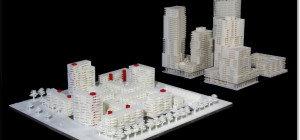 Spreader bars refer to a type of lifting device used by crane operators to hoist bulky and heavy loads. The legs of the sling are spread along the spreader bar, which allows for distribution of the load across the length of the bar. This, in turn, reduces the amount of hoisting power needed and increases the stability of the system.
Spreader bars refer to a type of lifting device used by crane operators to hoist bulky and heavy loads. The legs of the sling are spread along the spreader bar, which allows for distribution of the load across the length of the bar. This, in turn, reduces the amount of hoisting power needed and increases the stability of the system.
At the most basic level, spreader bars feature two lugs (attachment points) positioned at each end. The operator attaches the legs of a sling to the lugs to distribute the weight of the load before connecting the bar to a hoist, crane, or other lifting equipment. Spreader bars vary depending on the number of attachments (two or more) available on the underside to suspend the load.
Why should operators use a spreader bar?
There are many reasons why crane operators prefer to use spreader bars, especially over lifting bars. Advantages of spreader bars include:
1. Safe lifting
Spreader bars are designed to distribute the weight of the object over two or more lifting point. Moreover, the attachment points are positioned to allow for a vertical hoist, which makes it possible to lift loads that are likely to get damaged from angled slings. As such, spreader bars are mostly used to lift objects that are too large to balance from a single point, especially if they are not designed to handle adverse loading conditions due to slanting when lifting. These include concrete pipes, portable toilets, skip bins, dongas, and removable housing blocks, among others.
2. Availability in a range of styles and options for different applications
Operators can choose from a range of spreader bar styles depending on the application, including:
a) Spreader bars
A typical spreader bar has two lugs on the top side to transmit the weight to the hoist, and two lugs on the underside that the operator uses to attach the load being lifted. The idea is to keep the slings connecting the load to the bar as vertical as possible to provide an ideal loading scenario. The lines connecting the spreader bar to the hoist are usually angled at 45 or 60 degrees, so the bar must be designed to withstand the stress exerted by these angled lines.
To ensure that the weight of the load can be distributed through the entire length of the bar, operators can choose from:
• Adjustable spreader bars – These are telescopic bars that can be extended in length, and range from 1 to 60 feet, or even longer.
• Modular spreader bars – These are designed in pieces that can be easily assembled into a range of configurations to suit each application.
• Specialized pipe lifting bars – These bars are designed for pipe lifting equipment, like in the coal seam gas or pipeline industries
The idea for spreader bar length flexibility is to ensure that the bar has nearly zero bending when loaded. Moreover, the lugs are distributed on the underside to exert compressive forces when the load is attached. This is necessary to balance the tensile forces exerted when lifting, providing highly efficient structural loading that can handle very heavy loads.
b) Spreader beams
They differ from spreader bars in that spreader beams have a single attachment point on the top that goes to the crane. However, they offer multiple load attachment points on the underside. Their cross-section features an I-beam, which is where they got their name.
Spreader beams have a number of benefits, including:
• Multiple lugs on the bottom for even distribution of the load, as opposed to two hook points
• A single point connection to the crane, which reduces the vertical distance (height) that the crane needs to travel to lift, as there is no rigging on top of the beam.
• They can be turned upside down to use a single lifting point but with two different cranes. This is particularly important when the load exceeds the capacity of one crane.
However, spreader beams tend to be larger and heavier than spreader bars in order to eliminate bending from having a singular hoisting point.
c) Multiple spreader bars stacked together
When lifting a very large object, operators can stack multiple spreader bars on top of each other to distribute the weight across more points. You can use 3, 7 or more pieces of lifting equipment, though this causes the height of the slings to diminish. As a result, you need a very tall crane to supply enough height for all the rigging. You also need to involve a lift engineer to perform the operation safely.
Final note
It is important to ensure even load distribution, especially for long loads, to avoid spinning and tipping, which can result in injury and property damage. As such, always consult with a lift engineer to identify the best type of spreader bar rigging equipment for your application.
Sources
http://www.spartaengineering.com/need-spreader-bar/
https://www.alllifting.com.au/lifting-beams-spreader-bars
http://www.spartaengineering.com/spreader-bars-vs-lifting-beams/
http://www.uscargocontrol.com/Rigging-Supplies-Hardware/Lifting-Beams-and-Spreader-Bars







